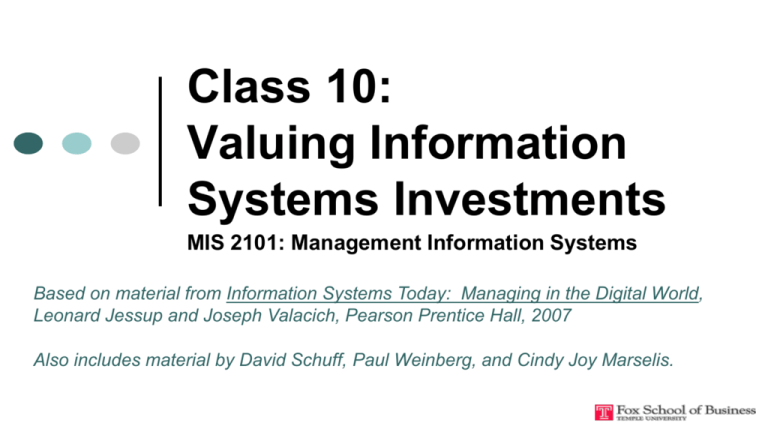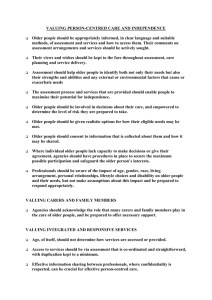
Class 10:
Valuing Information
Systems Investments
MIS 2101: Management Information Systems
Based on material from Information Systems Today: Managing in the Digital World,
Leonard Jessup and Joseph Valacich, Pearson Prentice Hall, 2007
Also includes material by David Schuff, Paul Weinberg, and Cindy Joy Marselis.
Learning Objectives
Discuss how organizations can use
information systems to help create a
strategic advantage
Describe how to create a business
case for an information system
Explain how to evaluate an
information system
Valuing Information Systems
What are three ways an Information
System can add value to an
organization?
Where do you think the most value is
added?
Valuing Information Systems
What do we mean
when we say we
can create
business value by
automating,
informing, and
supporting
strategy?
Automating
Informing
Strategy Support
Valuing Information Systems
Automating – doing things
FASTER
Valuing Information Systems
Informing – doing things
BETTER
Informing: Example
Tell me more
about the loan
processing
example from the
book…
Learning Organization
One that is skilled at creating, acquiring and
transferring knowledge and at modifying its
behavior to reflect new knowledge and
insights.
David Garvin, Harvard Business Review - 1993
Valuing Information Systems
Supporting Strategy– doing
things SMARTER
Strategizing: Five Types of
Organizational Strategies
What are
“Organizational
Strategies”?
Can technology be
leveraged to create
value supporting
these strategies?
Overall Low Cost Leadership
Strategy
What is an
example of a
company that
adopts an
overall low cost
leadership
strategy?
Focused Low-Cost Strategy
What is an
example of a
company that
adopts a
focused low
cost strategy?
Broad Differentiation
Strategy
What is an
example of a
company that
adopts a broad
differentiation
strategy?
Focused Differentiation
Strategy
What is an example
of a company that
adopts a focused
differentiation
strategy?
Best-Cost Provider Strategy
What is an example
of a company that
adopts a best-cost
provider strategy?
Strategizing: Five Types of
Organizational Strategies
Can technology be
leveraged to create
value supporting
these strategies?
Sources of Competitive
Advantage
Who has …
1.
Best-made product on the market
2.
Superior customer service
3.
Achieving lower costs than rivals
4.
Having proprietary manufacturing technology
5.
Having shorter lead times in research and development projects
6.
Having a well-known brand name and reputation
7.
Giving customers more value for their money
Can MIS professionals help you achieve this?
Competitive Advantage
How do you identify opportunities to use
information systems for competitive
advantage?
What are “Value Chains”?
What is “Porter’s Five Forces Model”?
Analysis tools or communication tools?
What is Value Chain Analysis?
Core
Value
Activities
Support
Value
Activities
IS and Value Chain Analysis
What are specific examples of how these IS functions add value and help create competitive advantages?
Why might it be important for systems supporting these activities to function at an enterprise level?
20
The Five Forces Model – Evaluating
Business Segments
Product returns
Increased
costsshare
Lower
market
Competition
in price,
Reduced
quality and
Lost distribution
customers
service
Decision support and
Reduce prices
business
intelligence
Increase
quality
CAD
product
redesign
Value added services
Electronic connections to
moreReduced
suppliersprices
ERP to
ERP
reduce
reduce
costs
costs
and
Better
web
presence
react CRM
more quickly
Lower
costs improve
through ERP,
CAD/CAM
quality
supply chain, etc.
Lost21market share
Buyer Power
What does it mean when “Buyer Power” is high?
How to loyalty programs influence buying power?
Can IT be the “enabler”?
Examples of situations where IT has increased buyer power?
How can I become the preferred supplier?
Supplier Power
What does it mean when “Supplier Power” is high?
How do tightly integrated supply chains influence supplier
power?
Examples of situations where IT has increased supplier power?
How can I increase my number of suppliers?
Threat of Substitute
Products or Services
When is the threat of substitute products high?
What are “switching costs” and how do they
influence the threat of substitute products?
Can IT be the “enabler”?
Examples of situations where IT has increased the threat of substitutes?
Can I increase switching costs?
Threat of New Entrants
Give an example of when the threat of new entrants is
high?
What is an “Entry Barrier” and how does this influence
the threat of new entrants?
Can IT be the “enabler”?
Examples of situations where IT has affected the threat of new entrants?
Can I create barriers to entry?
Rivalry Among Competition
Price, product, service and distribution?
How can you use IT?
Learning Objectives
Discuss how organizations can use
information systems to help create a
strategic advantage
Describe how to create a business
case for an information system
Explain how to evaluate an
information system
Making the Business Case for
an IS
Identification of benefits that the proposed
information system will bring to the organization
Automating benefits
Informing benefits
Strategic benefits
Productivity Gains
Easy to identify costs with developing an IS
How do you measure productivity gains?
Why hasn’t productivity increased at the
rate of IS investments?
The Productivity Paradox
Give an example
of how information
systems may be
used in
unintended ways.
Measurement Problems
Give an example of
how the wrong things
can be measured
Time Lags
When can the benefits of
an information system lag
behind the realized
benefits?
Redistribution
If an information
systems simply
redistributes the
pieces of the pie
rather than make the
pie bigger, does it
create any value?
Mismanagement
Can a good information
system overcome a bad
business model?
Making a Successful Business
Case
On what can we
base a
successful
business
case?
Arguments Based on Faith
Do you need a cost
benefits analysis for an
argument based on
faith?
Arguments Based on Fear
Do you need a cost
benefits analysis for an
argument based on
fear?
Come on, how do you
instill “fear” in an
organization?
Scenario
You are the CIO of a small to mid sized
company
You are meeting with an independent
consultant who is trying to get you to hire him
to develop a business continuity plan and a
disaster recovery plan
Is a business case based on “Fear” effective?
Business Continuity and
Disaster Recovery
Catastrophic loss of ability to deliver services from
primary location
Must resume services from alternate location
Disaster recovery plan driven by the business’
Recover time objective (RTO)
Recovery point objective (RPO)
Business Continuity – How you continue to provide
essential business services between time of the
disaster and the execution of DR plan
Sobering Statistics
From the U.S. National Fire Protection Agency and
the U.S. Bureau of Labor
Nearly 75% of all U.S. businesses have experienced a
business interruption
20% of small to medium size businesses suffer a major
disaster every five years
43% of US companies never reopen after a disaster and
29% close within three years
93% of companies that suffer a significant data lose are
out of business within five years
It’s not always what you expect
It’s in not always an earthquake or a hurricane
Arguments Based on Fear
Do you need a cost
benefits analysis for an
argument based on
fear?
Arguments Based on Fact
Do you need a
cost benefits
analysis for an
argument based
on fact?
Cost-Benefit Analysis
Identifying costs
What is “Total Cost of Ownership” (TCO)?
What are “Recurring vs. Non-recurring costs”?
What are “Tangible vs. Intangible costs”?
49
Learning Objectives
Discuss how organizations can use
information systems to help create a
strategic advantage
Describe how to create a business
case for an information system
Explain how to evaluate an
information system
Why is evaluation important?
Systems should address a business need
Otherwise
You waste money on what you buy
You still will have an unresolved “business
problem”
How do you evaluate
systems?
Understand what you need
Understand what the system does
Match the two up
Business
needs
52
Application
functionality
Understanding what you need
We talked about this way back
Talk to
People involved in the business process
Technical staff who have to implement the system
…to determine key features
MIS Analyst
53
Understanding what the
application does
Once you have the key features…
Talk to
Vendors
People who have bought or built similar products
Now you have a basis for comparing alternatives
System Evaluation
Questions
Who are the customers?
What are the business drivers (the
business case)?
Who are the participants?
Can the system create competitive
advantage?
What does the system do?
Are there risks with implementing the
system?
What type(s) of information system is
it?
What has to go “right” for the adopting
company?
What are the processes it performs?
Are they well-structured?
Are they well-integrated?
What are the key evaluation measures
for success?
How do you know if the system is
working?
An Evaluation Matrix for an
E-Mail System
Weighted average of feature ratings
Feature
Creates
mailing
lists
(10%)
Overall
cost
Web
access
Reliability
(30%)
(20%)
(40%)
Option A
7
1
8
5
4.6
Option B
3
9
4
5
5.8
Option
Total
Score
Partial Matrix of Functional
Requirements
Partial Matrix of Technical
Requirements
Partial Matrix of General
Requirements
Types of Systems
We’ve looked at different types of
information systems
Transaction Processing Systems (TPS)
Decision Support Systems (DSS)
Management Information Systems (MIS)
Types of Systems
We’ve looked at different types of
information systems
Transaction Processing Systems (TPS)
Decision Support Systems (DSS)
Management Information Systems (MIS)
Types of Applications…
Different types of applications
1.
2.
3.
4.
5.
Customer relationship management
Business intelligence
Enterprise resource planning
Order entry/point-of-sale
Accounting (Accounts Payable/Receivable)
In-Class Activity
Working in a small team of 3-4 business
professionals on a project for the CEO of Fitter
Snacker…
Each team will be assigned an application which
is being considered for use at Fitter Snacker
Your team will evaluate the application and
prepare to answer the following questions for
the CEO…
Can your team answer…
Who are the customers?
What are the business drivers (the
business case)?
Who are the participants?
Can the system create competitive
advantage?
What does the system do?
Are there risks with implementing the
system?
What type(s) of information system is
it?
What has to go “right” for the adopting
company?
What are the processes it performs?
Are they well-structured?
Are they well-integrated?
What are the key evaluation measures
for success?
How do you know if the system is
working?








